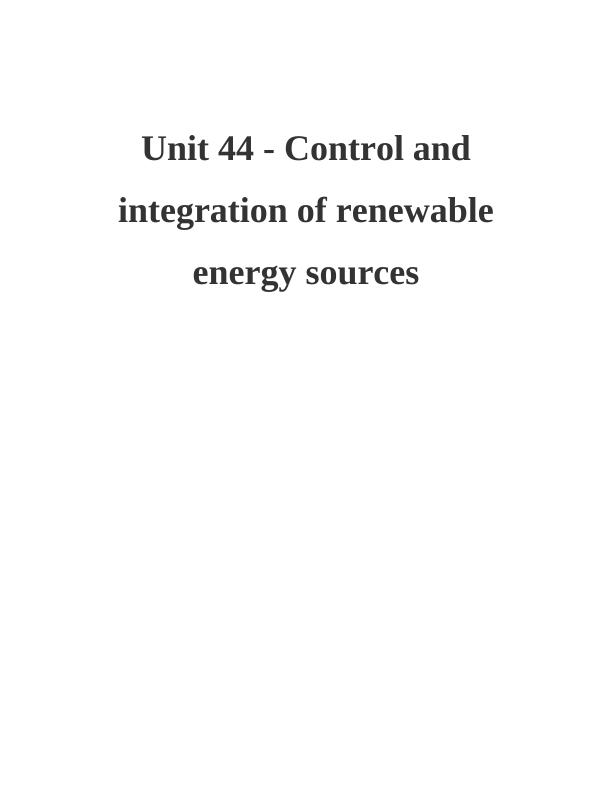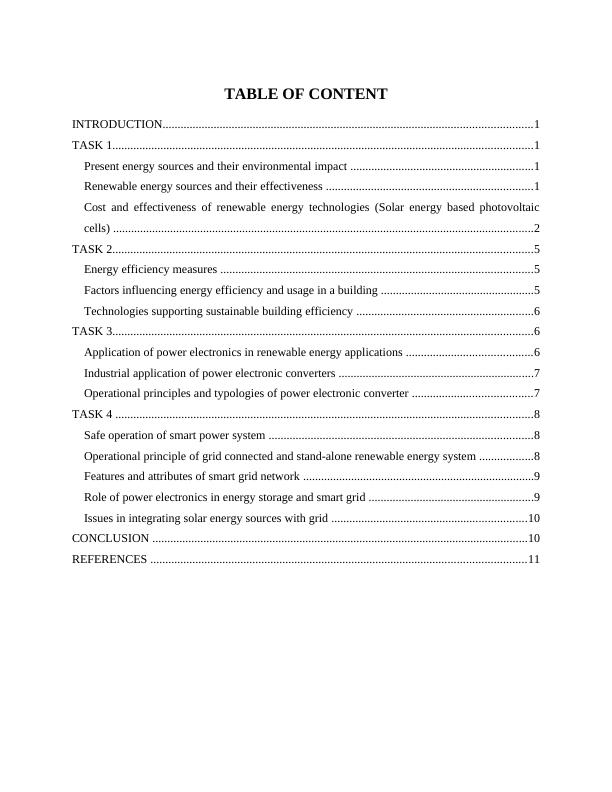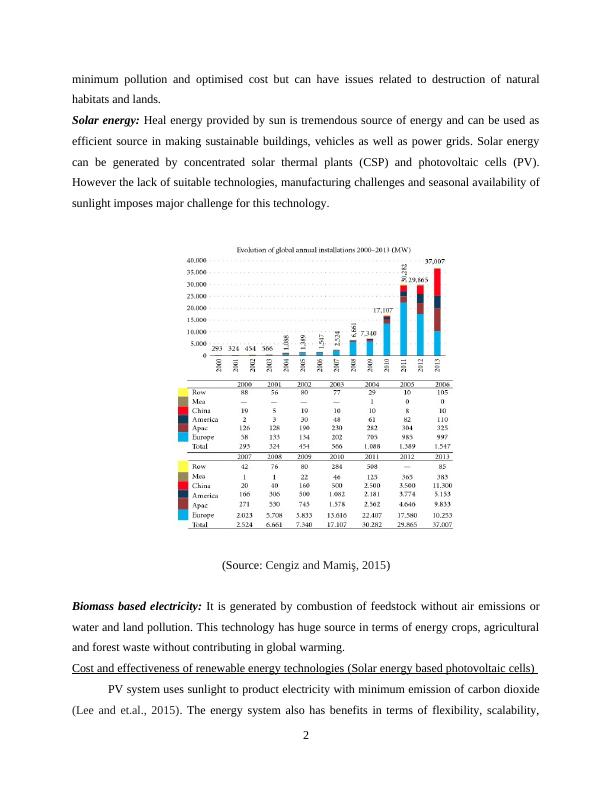Control and Integration of Renewable Energy Sources
13 Pages3928 Words99 Views
Added on 2023-01-19
About This Document
This study material explores the control and integration of renewable energy sources. It covers topics such as present energy sources and their environmental impact, renewable energy effectiveness, cost and effectiveness of solar energy technologies, energy efficiency measures, power electronics in renewable energy applications, and safe operation of smart power systems.
Control and Integration of Renewable Energy Sources
Added on 2023-01-19
ShareRelated Documents
Unit 44 - Control and
integration of renewable
energy sources
integration of renewable
energy sources

TABLE OF CONTENT
INTRODUCTION...........................................................................................................................1
TASK 1............................................................................................................................................1
Present energy sources and their environmental impact .............................................................1
Renewable energy sources and their effectiveness .....................................................................1
Cost and effectiveness of renewable energy technologies (Solar energy based photovoltaic
cells) ............................................................................................................................................2
TASK 2............................................................................................................................................5
Energy efficiency measures ........................................................................................................5
Factors influencing energy efficiency and usage in a building ...................................................5
Technologies supporting sustainable building efficiency ...........................................................6
TASK 3............................................................................................................................................6
Application of power electronics in renewable energy applications ..........................................6
Industrial application of power electronic converters .................................................................7
Operational principles and typologies of power electronic converter ........................................7
TASK 4 ...........................................................................................................................................8
Safe operation of smart power system ........................................................................................8
Operational principle of grid connected and stand-alone renewable energy system ..................8
Features and attributes of smart grid network .............................................................................9
Role of power electronics in energy storage and smart grid .......................................................9
Issues in integrating solar energy sources with grid .................................................................10
CONCLUSION .............................................................................................................................10
REFERENCES .............................................................................................................................11
INTRODUCTION...........................................................................................................................1
TASK 1............................................................................................................................................1
Present energy sources and their environmental impact .............................................................1
Renewable energy sources and their effectiveness .....................................................................1
Cost and effectiveness of renewable energy technologies (Solar energy based photovoltaic
cells) ............................................................................................................................................2
TASK 2............................................................................................................................................5
Energy efficiency measures ........................................................................................................5
Factors influencing energy efficiency and usage in a building ...................................................5
Technologies supporting sustainable building efficiency ...........................................................6
TASK 3............................................................................................................................................6
Application of power electronics in renewable energy applications ..........................................6
Industrial application of power electronic converters .................................................................7
Operational principles and typologies of power electronic converter ........................................7
TASK 4 ...........................................................................................................................................8
Safe operation of smart power system ........................................................................................8
Operational principle of grid connected and stand-alone renewable energy system ..................8
Features and attributes of smart grid network .............................................................................9
Role of power electronics in energy storage and smart grid .......................................................9
Issues in integrating solar energy sources with grid .................................................................10
CONCLUSION .............................................................................................................................10
REFERENCES .............................................................................................................................11

INTRODUCTION
Renewable energy is defined as the energy source which can be replenished by natural
processes or within fix duration of time preventing their depletion with even rising demands. At
present the primary energy sources such as nuclear or fossil fuel based energy is being used by
the world (Sampaio and González, 2017). However the the severe environmental hazards with
their increasing exploitation as well as the increasing scarcity of primary resources to fulfil the
needs of rising work population demands for the alternative choice of renewable resources.
The report will analyse the efficiency and impact of renewable energy sources and will
apply solar technology based systems to enhance the efficiency of buildings, vehicles and other
systems. It will also discuss the power electronics converters and smart grid networks in
renewable energy field so that global energy demands can be fulfilled and environmental
consequences of primary energy sources can also be reduced.
TASK 1
Present energy sources and their environmental impact
There are two types of energy resources namely primary and renewable. The primary
energy sources such as fossil fuel based energies like coal, petroleum, natural gas and nuclear
energy. These are defined as the natural resources which are extracted from the earth and which
are available in limited quantity. Their increasing global consumption is resulting in their quick
depletion as well as severe environmental hazards. The potential implications includes climate
change, land, water ans soil pollution and scarcity of natural resources (Khelifa and et.al., 2016).
The second type of energy resources are known as renewable energy sources which can be easily
replenished because of their vast energy sources. Example of renewable energy includes solar
energy, wind energy, geothermal and biomass energy which not minimise the climate change
and pollution but also have limitless potential to meet all energy requirements of the world. Due
to exploitation of resources or natural availability along with environmental consequences
different parts of the world are facing challenges in continuous use of primary resources.
Renewable energy sources and their effectiveness
Various types of renewable energy resources are as follows:
Wind energy: The wind is affordable, abundant and inexhaustible and thus it is viable and
sustainable source of energy (Paranthaman, Wong-Ng and Bhattacharya, 2016). It involves
1
Renewable energy is defined as the energy source which can be replenished by natural
processes or within fix duration of time preventing their depletion with even rising demands. At
present the primary energy sources such as nuclear or fossil fuel based energy is being used by
the world (Sampaio and González, 2017). However the the severe environmental hazards with
their increasing exploitation as well as the increasing scarcity of primary resources to fulfil the
needs of rising work population demands for the alternative choice of renewable resources.
The report will analyse the efficiency and impact of renewable energy sources and will
apply solar technology based systems to enhance the efficiency of buildings, vehicles and other
systems. It will also discuss the power electronics converters and smart grid networks in
renewable energy field so that global energy demands can be fulfilled and environmental
consequences of primary energy sources can also be reduced.
TASK 1
Present energy sources and their environmental impact
There are two types of energy resources namely primary and renewable. The primary
energy sources such as fossil fuel based energies like coal, petroleum, natural gas and nuclear
energy. These are defined as the natural resources which are extracted from the earth and which
are available in limited quantity. Their increasing global consumption is resulting in their quick
depletion as well as severe environmental hazards. The potential implications includes climate
change, land, water ans soil pollution and scarcity of natural resources (Khelifa and et.al., 2016).
The second type of energy resources are known as renewable energy sources which can be easily
replenished because of their vast energy sources. Example of renewable energy includes solar
energy, wind energy, geothermal and biomass energy which not minimise the climate change
and pollution but also have limitless potential to meet all energy requirements of the world. Due
to exploitation of resources or natural availability along with environmental consequences
different parts of the world are facing challenges in continuous use of primary resources.
Renewable energy sources and their effectiveness
Various types of renewable energy resources are as follows:
Wind energy: The wind is affordable, abundant and inexhaustible and thus it is viable and
sustainable source of energy (Paranthaman, Wong-Ng and Bhattacharya, 2016). It involves
1

minimum pollution and optimised cost but can have issues related to destruction of natural
habitats and lands.
Solar energy: Heal energy provided by sun is tremendous source of energy and can be used as
efficient source in making sustainable buildings, vehicles as well as power grids. Solar energy
can be generated by concentrated solar thermal plants (CSP) and photovoltaic cells (PV).
However the lack of suitable technologies, manufacturing challenges and seasonal availability of
sunlight imposes major challenge for this technology.
(Source: Cengiz and Mamiş, 2015)
Biomass based electricity: It is generated by combustion of feedstock without air emissions or
water and land pollution. This technology has huge source in terms of energy crops, agricultural
and forest waste without contributing in global warming.
Cost and effectiveness of renewable energy technologies (Solar energy based photovoltaic cells)
PV system uses sunlight to product electricity with minimum emission of carbon dioxide
(Lee and et.al., 2015). The energy system also has benefits in terms of flexibility, scalability,
2
habitats and lands.
Solar energy: Heal energy provided by sun is tremendous source of energy and can be used as
efficient source in making sustainable buildings, vehicles as well as power grids. Solar energy
can be generated by concentrated solar thermal plants (CSP) and photovoltaic cells (PV).
However the lack of suitable technologies, manufacturing challenges and seasonal availability of
sunlight imposes major challenge for this technology.
(Source: Cengiz and Mamiş, 2015)
Biomass based electricity: It is generated by combustion of feedstock without air emissions or
water and land pollution. This technology has huge source in terms of energy crops, agricultural
and forest waste without contributing in global warming.
Cost and effectiveness of renewable energy technologies (Solar energy based photovoltaic cells)
PV system uses sunlight to product electricity with minimum emission of carbon dioxide
(Lee and et.al., 2015). The energy system also has benefits in terms of flexibility, scalability,
2

End of preview
Want to access all the pages? Upload your documents or become a member.
Related Documents
Unit 44 - Control and integration of renewable energy sourceslg...
|16
|3875
|38
Renewable Energy Design in Asialg...
|23
|6865
|261
Challenges and Development of Nuclear Energy in Australialg...
|43
|9835
|154
Viability and Sustainability of Renewable Energylg...
|32
|5789
|307
Control and Integration of Renewable Energy Sourceslg...
|15
|3656
|46
Increasing the proportion of Renewable Energy in Australia’s Energy Mixlg...
|13
|3846
|467
